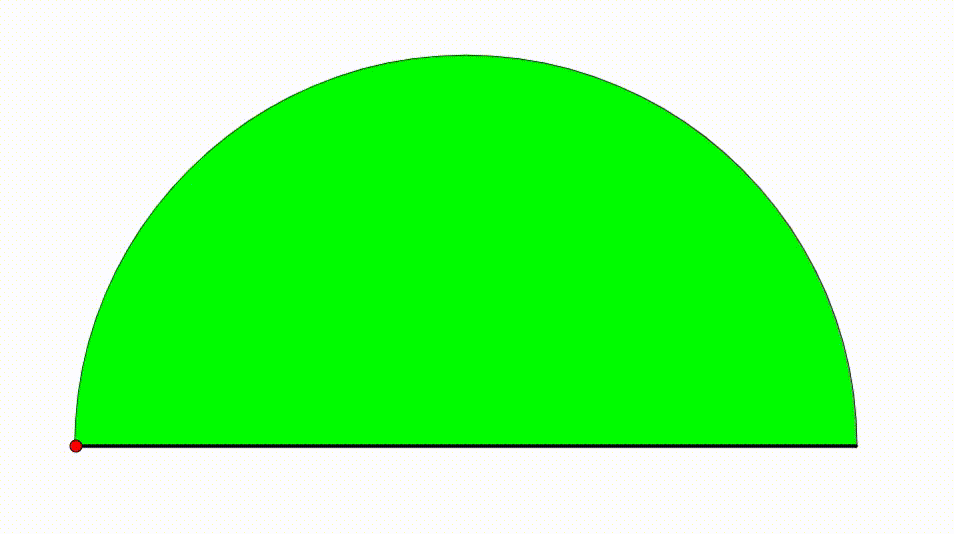Dynamic Geometry: P76
 The diagram shows a black semicircle with radius
. The cyan and the green semicircles are tangent to each other and internally tangent to the black semicircle. They are growing and shrinking freely so that the sum of their radius is always equal to
. We inscribe a purple semicircle so that it's tangent to all three semicircles. When the radius of the purple semicircle is equal to
, the sum of the areas of the cyan and green semicircles can be expressed as
, where
and
are coprime positive integers. Find
.
The diagram shows a black semicircle with radius
. The cyan and the green semicircles are tangent to each other and internally tangent to the black semicircle. They are growing and shrinking freely so that the sum of their radius is always equal to
. We inscribe a purple semicircle so that it's tangent to all three semicircles. When the radius of the purple semicircle is equal to
, the sum of the areas of the cyan and green semicircles can be expressed as
, where
and
are coprime positive integers. Find
.
The answer is 307.
This section requires Javascript.
You are seeing this because something didn't load right. We suggest you, (a) try
refreshing the page, (b) enabling javascript if it is disabled on your browser and,
finally, (c)
loading the
non-javascript version of this page
. We're sorry about the hassle.
Let the centers of the unit, cyan, green, and purple semicircles be O , A , B , and C , their radii 1 , r 1 , r 2 , and r , Then r 1 + r 2 = 1 , O A = 1 − r 1 = r 2 , and O B = 1 − r 2 = r 1 .
Let diameters D E and F G through centers C and O respectively. By intersecting chords theorem ,
D C ⋅ C E r 2 ⟹ k 2 = F C ⋅ C G = ( 1 − k ) ( 1 + k ) = 1 − k 2 = 1 − r 2
Let ∠ C O B = θ . By cosine rule ,
{ B C 2 = O B 2 + O C 2 − 2 ⋅ O B ⋅ O C ⋅ cos θ C A 2 = O A 2 + O C 2 + 2 ⋅ O A ⋅ O C ⋅ cos θ { ( r 2 + r ) 2 = r 1 2 + ( 1 − r 2 ) − 2 r 1 1 − r 2 cos θ ( r 1 + r ) 2 = r 2 2 + ( 1 − r 2 ) + 2 r 2 1 − r 2 cos θ . . . ( 1 ) . . . ( 2 ) r 2 × ( 1 ) + r 1 × ( 2 ) : r 1 3 + r 2 3 + 2 ( r 1 2 + r 2 2 ) r + ( r 1 + r 2 ) r 2 ( r 1 + r 2 ) ( ( r 1 + r 2 ) 2 − 3 r 1 r 2 ) + 2 ( ( r 1 + r 2 ) 2 − 2 r 1 r 2 ) r + r 2 1 − 3 r 1 r 2 + 2 r − 4 r 1 r 2 r + r 2 r + r 2 ⟹ r = r 1 r 2 ( r 1 + r 2 ) + ( r 1 + r 2 ) ( 1 − r 2 ) = r 1 r 2 + 1 − r 2 Note that r 1 + r 2 = 1 = r 1 r 2 + 1 − r 2 = 2 r 1 r 2 + 2 r 1 r 2 r = 2 r 1 r 2
Putting r = 1 2 1 5 6 , then we have:
2 r 1 r 2 r 1 ( 1 − r 1 ) 1 2 1 r 1 2 − 1 2 1 r 1 + 2 8 ( 1 1 r 1 − 4 ) ( 1 1 r 1 − 7 ) ⟹ r 1 , r 2 = 1 2 1 5 6 = 1 2 1 2 8 = 0 = 0 = 1 1 4 , 1 1 7 Note that r 2 = 1 − r 1 Since r 1 and r 2 are interchangeable,
Then the sum of areas of the cyan and green semicircles 2 π ( ( 1 1 4 ) 2 + ( 1 1 7 ) 2 ) = 2 4 2 6 5 . Therefore p + q = 6 5 + 2 4 2 = 3 0 7 .